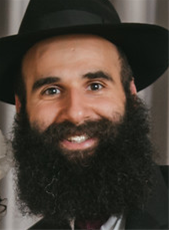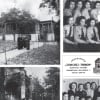The year was 1940, and Avraham Tzvi Landa had every reason to be scared. A Polish refugee in Vilna (Vilnius), he had recently joined the Chabad yeshivah there. While his fellow students were on a list to receive visas to the United States, he was not. His family was trapped in Nazi-occupied Poland, and he faced the prospect of remaining all alone.
As in the past, he wrote to the Sixth Lubavitcher Rebbe—Rabbi Yosef Yitzchak Schneersohn, of righteous memory—for help. In order to bypass censors, the reply was written with no letterhead.
With fatherly concern, the Rebbe assured the young man that he would be added to the list and that all efforts would be made to help him. The letter began, however, with an assurance to the 21-year-old that G‑d would give him “... long, good and illuminating days and years, within the tent of Torah.”
None of those American visas ever materialized, but Avraham Tzvi and his fellow students managed to escape to the Far East using Japanese visas granted by the legendary consul Chiune Sugihara, spending the remainder of the war in Shanghai, China. For Landa, the blessing for long life carried him through until he passed away in his sleep on Feb. 15, only hours before the start of Shabbat, at the age of 100.
His special blessing was known among his peers, who over the years would relate to his children that whenever bombs fell or they sailed on stormy seas, many of them would huddle around him.
He was the last of the group of Polish Chabad yeshivah students who survived the Holocaust in Kobe, Japan, and then in Shanghai.

The Mingling of Chassidic Yeshivah Students
Avraham Tzvi was born in 1918 in the Galician city of Sanz, the oldest of six siblings. His parents, Yehuda and Tilla Baila Landa, belonged to the community of Sadigura Chassidim.
Yehuda was a respected shochet (ritual slaughterer), who was a descendant of Rabbi Yechezkel Landau, famed rabbi of Prague, widely known as the Nodeh BiYehudah. Like their well-known ancestor, the Landas also used the surname Segal to denote their status as Levites (on legal documents, his last name was Falman).
When Avraham Tzvi was a child, the family relocated to Rimanov (Rymanów).
Since Galicia did not have organized yeshivahs, Avraham Tzvi was recruited to study in the Lithuanian city of Pinsk. There, he was pained to see students like himself, with deep Chassidic roots, shedding their unique customs and fervor in an effort to conform to their non-Chassidic surroundings. During that period, he also read about the Sixth Rebbe in the Yiddish book Di Yisurim Fun Lubavitcher Rebbin (“The Travails of the Lubavitcher Rebbe”). He was impressed by the Rebbe’s sacrifice for and commitment to the Jewish people, and his heroic efforts on behalf of Soviet Jewry.
Upon learning that he could write to the Rebbe and receive spiritual guidance, Landa penned a letter to the Rebbe, requesting direction in establishing his path in serving G‑d. “... I am also perplexed regarding my responsibility to others. I still have a great deal of arduous work remaining for my own personal improvement and purification. Am I also required to set aside time for the improvement of others, especially the masses? And how much time am I to devote for this purpose?” he wrote.

When the Molotov-Ribbentrop Pact put Western Poland under German rule and Eastern Poland under Soviet occupation, many yeshivah students streamed to Vilna, Lithuania, where they hoped for a gentler regime and the chance to immigrate to the United States. This created a unique situation, where students of various yeshivahs (including the Pinsk yeshivah) were rubbing shoulders and interacting with other students.
In his early 20s, Landa began organizing classes and gatherings for Chassidic students of non-Chassidic yeshivahs, which now found themselves gathered in Vilna. He was also active in disseminating pamphlets with the teachings of the Rebbe.
He reported his activities to the Rebbe, who chose to name his ad hoc organization, Igud Talmedai Hayeshivos Migeza Hachasidim Biyeshivos Shonos, “Union of Students of Chassidic Stock in Various Yeshivot.” The organization included students of the yeshivahs of Kaminetz, Kletzk, Lomzha, Brisk, Chachmei Lublin and others, all of whom found themselves in Vilna.
In addition to inquiring about his activities—and responding with encouraging letters and providing guidance—the Rebbe sent financial support as well, enabling Landa to distribute materials and organize events. In his various letters written in 1940, the Rebbe expressed keen interest in various details of the organization and its participants.
Having learned Chabad chassidus on his own, Landa asked the Rebbe for permission to teach Tanya, even though much of it he hadn’t studied from an established Chassid and feared that he may misunderstand some of the finer points of the book. The Rebbe heartily blessed his efforts.
The organization and its efforts were applauded by other Chassidic rebbes as well, notably Rabbi Shaul Taub of Modzhitz and Rabbi Shimon Shalom Kalisch of Amshinov, of righteous memory.

Surviving the War Years in China
In the summer of 1940, Landa transferred to the Chabad yeshivah in Vilna, cementing his identity as a Chabad Chassid.
He personified the ideas of Chabad, which emphasizes the primacy of thought over unbridled emotion, earnestness and sincerity. Throughout his 100 years of life, every day was carefully crafted, every moment accounted for, and every move carefully planned. Everything had a purpose, a small step in his lifelong path of serving G‑d.
In the yeshivah, he studied at the feet of the famed Chassidic mentor, Rabbi Yehoshua Isaac Baruch, who died at the hands of the Nazis.
Shortly after arriving at the yeshivah on the 12th of Tammuz, he discovered that a list had been submitted for visas to the U.S., and he feared that he would be left behind. It was in response to those fears that the Rebbe wrote his reassuring letter—a letter that he would treasure for the rest of his life.

Through the heroic assistance of Sugihara, the Japanese consul to Kaunas (Kovno), Lithuania, Landa and his fellow students left for Japan via the Russian heartland hoping to obtain U.S. visas at the American embassy in Moscow. In Moscow, they were told to continue along the trans-Siberian railroad towards Japan. Before leaving, under the watchful eye of the KGB, they gave the Russian Chassidim messages of hope from the Rebbe, in addition to religious articles, including their own tefillin.
They then crossed Siberia to Vladivostok, sailing the Sea of Japan to Kobe, where they immediately resumed their rigorous regimens of prayer and study, despite the unusual surroundings.
Upon realizing that they would not be able to leave Japan for America, the group was eventually forced to board a ship to Shanghai, China, which was then home to thousands of Jewish refugees.
After the war, following five years of relative isolation, Landa and his peers began to hear of the devastation that the Nazis had brought upon Polish Jewry. His parents had both been murdered and only one sibling, a younger brother, survived the inferno.
Rebuilding Life in America

Upon arriving in New York in June of 1946, virtually alone in the world, he once again turned to the Rebbe for comfort and guidance. With the Rebbe’s advice and encouragement, in 1948, he married Chaya Klein, a native of Hungary who had survived Auschwitz. Rabbi Yoel Teitelbaum of Satmar, of righteous memory, conducted the wedding.
Following the advice of the seventh Lubavitcher Rebbe—Rabbi Menachem M. Schneerson, of righteous memory—the Landas settled in the Boro Park neighborhood of Brooklyn, where they built a family.
Rabbi Landa began teaching children Torah. Patient and kind, he was well-suited for the task and enjoyed his work immensely. After several decades of teaching, to his surprise, the Rebbe advised him to reject a teaching offer and instead take a job with the U.S. Postal Service.
Ever the Chassid, he used his position to spread Jewish awareness and observance among his fellow postal workers, including putting on tefillin with whoever agreed to do so.
Punctilious with his work at the post office, he woke up early in the morning to pray in an unhurried and contemplative manner, and would devote his evenings to studying and teaching Torah.

Owing to the Rebbe’s advice, upon reaching retirement age nearly 20 years later, he was able to draw a pension from the post office, which supported him and his wife with dignity for more than three decades.
Until his last years, he taught Chassidus in various synagogues and yeshivahs in Boro Park, continuing the work he began in wartime Vilna. “You would never know how many people just watched him,” recalled Yanky Hager, a regular at the Vizhnitz Chassidic synagogue where he prayed. “They would watch how he learns, how he prays, how he lives every moment as a Jew.”
This continued until his final decade, when he moved into the home of his daughter, Rivky Kirsh, in Brooklyn’s Crown Heights neighborhood. Until he fractured his hip at the age of 98, he would attend synagogue daily, humbly and without fanfare.
Predeceased by his wife last winter, he remained lucid until his final day, actualizing the Rebbe’s prediction of “... long, good and illuminating days and years, within the tent of Torah.” He is survived by his children: Yehuda Landa (New Jersey), Rabbi Yisroel Dovid Landa (Brooklyn, N.Y.), Rabbi Yosef Landa (St. Louis), Rivky Kirsh (Brooklyn, N.Y.); and many grandchildren and great-grandchildren.






Join the Discussion